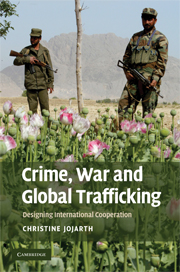Book contents
- Frontmatter
- Contents
- List of figures
- List of tables
- List of abbreviations
- Preface and acknowledgments
- 1 Introduction
- 2 The concept of legalization
- 3 Problem constellation
- 4 Narcotic drugs: UN Convention against Illicit Traffic in Narcotic Drugs and Psychotropic Substances
- 5 Money laundering: the Financial Action Task Force and its Forty Recommendations
- 6 Conflict diamonds: the Kimberley Process Certification Scheme
- 7 Small arms and light weapons: the United Nations Program of Action
- 8 Conclusion
- References
- Index
- References
References
Published online by Cambridge University Press: 02 July 2009
- Frontmatter
- Contents
- List of figures
- List of tables
- List of abbreviations
- Preface and acknowledgments
- 1 Introduction
- 2 The concept of legalization
- 3 Problem constellation
- 4 Narcotic drugs: UN Convention against Illicit Traffic in Narcotic Drugs and Psychotropic Substances
- 5 Money laundering: the Financial Action Task Force and its Forty Recommendations
- 6 Conflict diamonds: the Kimberley Process Certification Scheme
- 7 Small arms and light weapons: the United Nations Program of Action
- 8 Conclusion
- References
- Index
- References
- Type
- Chapter
- Information
- Crime, War, and Global TraffickingDesigning International Cooperation, pp. 287 - 318Publisher: Cambridge University PressPrint publication year: 2009



